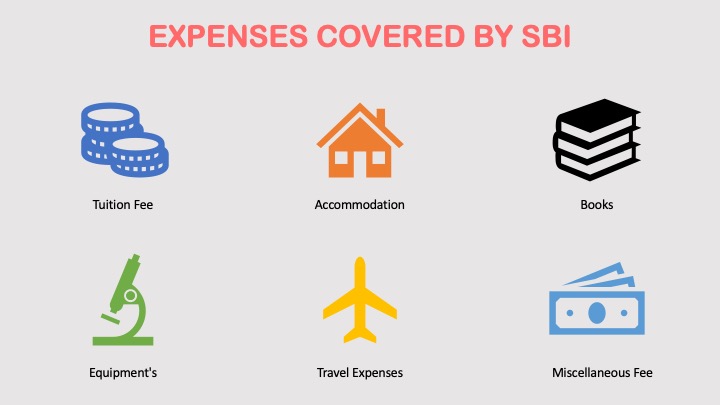Embarking on a study abroad journey is an exciting and enriching experience, but financing it can sometimes feel like navigating a complex puzzle. If you've chosen SBI for your education loan, fret not! This post simplifies the disbursement process, guiding you through each step from loan sanction to fund transfer, highlighting the expenses covered by SBI, and addressing exceptional cases for specific countries.
-
Loan Sanction: The Green Light
- Loan Sanction Letter: Once your loan application is approved, the bank issues a sanction letter stating the approved loan amount, interest rate, repayment terms, and other key details. This document is valid for 6 months, during which you need to complete the disbursement formalities.
- Loan Agreement Signing: Both you (the applicant) and your co-applicant (if applicable) must physically sign a loan agreement with the bank. This legally binds you to the terms of the loan and outlines your responsibilities as a borrower.
- Loan Account Opening: After the agreement is signed, the bank opens a dedicated loan account under your name. This account will track the loan amount, interest accruals, and payments made until the loan is fully repaid.
- Original Document Submission: You'll need to submit all original documents mentioned in the sanction letter and loan agreement. These typically include passport, admission letter, fee structure documents, academic records, income proof of co-applicant (if applicable), and property documents for creating an equitable mortgage.
- Equitable Mortgage: This is a specific security measure where you deposit the title deed of a property (usually owned by you or your co-applicant) with the bank. This acts as collateral for the loan, ensuring the bank receives the property if you default on the repayments. The title deed is returned to you once the loan is fully repaid.
- Loan Sanction Letter: Once your loan application is approved, the bank issues a sanction letter stating the approved loan amount, interest rate, repayment terms, and other key details. This document is valid for 6 months, during which you need to complete the disbursement formalities.
-
Document Collection: Proof of Your Study Expenses
- University Demand Letter with Fee Structure: This official document from your university details the exact tuition fees and other charges for your chosen program. It's crucial proof of your study expenses and helps the bank determine the required loan amount.
- On-Campus Accommodation:
- Fee Breakup: If you're opting for on-campus accommodation, you'll need to provide proof of the fees associated with it. This could involve a breakdown of charges for room, meals, and other related services.
- Fee Breakup: If you're opting for on-campus accommodation, you'll need to provide proof of the fees associated with it. This could involve a breakdown of charges for room, meals, and other related services.
- Off-Campus Accommodation:
- Rent Agreement: For off-campus accommodation, a signed rent agreement with the landlord serves as proof of your expected monthly housing expenses.
- Rent Agreement: For off-campus accommodation, a signed rent agreement with the landlord serves as proof of your expected monthly housing expenses.
- Estimate of Average Living Costs: This includes all anticipated non-accommodation expenses like food, clothing, study materials, and essential equipment like laptops or gadgets. Provide a realistic breakdown of these costs to ensure the loan covers your basic needs.
- Clear Breakdown of Health Insurance, Travel Costs, and Study Aids: These elements often involve specific documentation:
- Health Insurance: Provide proof of adequate health insurance coverage for your study duration. This often involves the insurance policy document or a certificate from the provider.
- Travel Costs: Documentation for estimated airfare or other travel expenses related to your studies could involve flight bookings or travel agency quotations.
- Study Aids: If you require specific study aids or materials not covered by tuition fees, provide details and estimated costs (receipts or quotes) to justify their inclusion in the loan coverage.
- Health Insurance: Provide proof of adequate health insurance coverage for your study duration. This often involves the insurance policy document or a certificate from the provider.
- University Demand Letter with Fee Structure: This official document from your university details the exact tuition fees and other charges for your chosen program. It's crucial proof of your study expenses and helps the bank determine the required loan amount.
-
Expenses Covered: Your Financial Wings
SBI education loans for abroad studies typically cover expenses like:

- Tuition fees: Up to 100% of the actual tuition fees for the entire course duration.
- Examination fees: Fees related to the course.
- Library fees: Fees charged for accessing the university library.
- Laboratory fees: Fees associated with practical sessions and lab work.
- Books and study materials: Up to 10% of the total tuition fees.
- Travel expenses: Airfare or other travel costs for studies abroad, up to a specific limit based on the chosen country and course.
- Computer purchase: Up to 20% of the total tuition fees for essential laptops or equipment needed for the course.
- Caution deposit/building fund: Up to 10% of the total tuition fees for refundable deposits required by the university.
- Other study-related expenses: Some schemes may cover additional expenses like study tours, project work, or thesis costs, subject to specific conditions.
- Tuition fees: Up to 100% of the actual tuition fees for the entire course duration.
-
Exceptional Cases: Landing in Specific Countries
- Pre-visa disbursement: Available for most countries, this helps cover initial expenses like application fees or travel costs even before your visa arrives.
- US bound? An I-20 form issued by your university is mandatory for loan disbursement.
- Heading to Germany? SBI offers options like GICs and blocked accounts to secure your funds and meet immigration regulations.
- Pre-visa disbursement: Available for most countries, this helps cover initial expenses like application fees or travel costs even before your visa arrives.
Remember:
This information is based on general knowledge and publicly available resources. Always refer to your loan documents and contact SBI for personalized guidance and country-specific requirements.
With this roadmap in hand, you can navigate the SBI education loan disbursement process like a pro. Bon voyage and good luck with your studies abroad!
